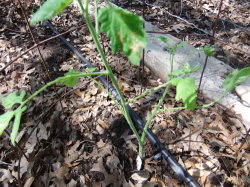
Want to know my secrets for growing the biggest, best-tasting tomatoes ever?
In early spring, I planted several heritage variety plants in fortified soil, and I’m now watching them grow in anticipation of harvesting loads of great homegrown tomatoes. If you look at my tomato plants you may ask, “What happened to all the leaves and branches?” My answer, “I removed them.”
Most gardeners grow lots of leaves and stems but very few tomatoes. Why? Have you considered that leaves and stems consume the bulk of moisture, nutrients and oxygen, which are required to produce great tomatoes? Tomatoes love water and oxygen and sunshine. Did you ever consider that leaves and stems also prevent airflow, filter the sunshine and use most of the plant’s water? This came to me one day, as I was watching those pesky giant-green caterpillars stripping the tomato leaves off all my plants. After I removed the caterpillars, I felt hopeless as I observed the remaining, ravaged stems. But, about three weeks later I noticed my plants were full of blossoms. Blossoms produce fruit, and, shortly, I had an abundance of the best tomatoes ever.
I began wondering if God sent the caterpillars to remove the leaves so I could enjoy a good crop. Do you think “Mr. Caterpillar” was trying to teach me something?
When I planted my fall tomatoes, I decided to remove the leaves to see if the plants would respond the same way. And sure enough, they did. This fall crop was fantastic also, and I never noticed any caterpillars. I surmise that when the caterpillar moths were looking for a tomato garden to lay their eggs in, they took one look at mine and decided to move on.

I’ve since refined my pruning techniques, and I would like to share my secrets with you.
When your plants are about 12-inches tall, remove all but the top six leaves. Yes, leave only six leaves right at the top. Your plants will look bald and unhappy, but that’s OK. The next step is to count the branches on the plant. Beginning with the smallest branches, use scissors to cut off half the total number of branches as close to the trunk as possible. Yes, half. I know what you’re thinking. Just trust me. Your tomato plants are going to be just fine.
Next, place a covering of leaves, small wood-chips, mulch, etc., on the soil. Your goal is to build a 1-inch to 2-inch covering of natural material on the floor of your garden. This insulates the soil and provides a natural, nutrient supply as the material breaks down.
Tomato plants do best with periodic feeding-sprays, rather than solid fertilizer. I use a mixture of liquid seaweed, organic vinegar and Epsom salts (magnesium sulfate). I also recommend Medina Hasta-Grow liquid plant food, according to their instructions. Remember to water only in the morning on warm, sunny days.
If you would like to receive other natural gardening tips, please send me an email at info@nutritionfarmacy.com or check out my website, www.nutritionfarmacy.com.